To Be Continued: Six Short-Lived Sci-Fi Series That Deserve A Comic-Book Resurrection
I'd give my left arm to finish Crusade.
This article is more than 2 years old
 Firefly fans got great news earlier this week with the official announcement of Serenity: Leaves on the Wind, an upcoming comic book series that picks up with Malcolm Reynolds and his (surviving) crew in the aftermath of the 2005 movie. It may not be as exciting as an actual new TV series or movie, but it’s still very cool. It also got us thinking: what other short-lived science fiction shows would we love to revisit on the comics page?
Firefly fans got great news earlier this week with the official announcement of Serenity: Leaves on the Wind, an upcoming comic book series that picks up with Malcolm Reynolds and his (surviving) crew in the aftermath of the 2005 movie. It may not be as exciting as an actual new TV series or movie, but it’s still very cool. It also got us thinking: what other short-lived science fiction shows would we love to revisit on the comics page?
There’s already plenty of precedent, after all. Even before the announcement of Leaves on the Wind, many different genre series had found extended life in comics form. In addition to the Firefly/Serenity universe, Joss Whedon’s Buffy the Vampire Slayer, Angel, and Dollhouse have all continued to explore their respective universes to varying degrees. So have shows such as Farscape and Jericho. Hell, there’s even a new Six Million Dollar Man comic that will pick up where the 1978 TV series finale left off.
That’s one of the great things about continuing something in comic form. It doesn’t matter how much time has passed. It doesn’t matter how old the actors are. The characters have remained timeless, just waiting for us to join them again for another adventure. The list below are my picks for six prematurely cancelled series I’d love to see reborn as comics. Sound off with your thoughts and your own picks in the comments below!
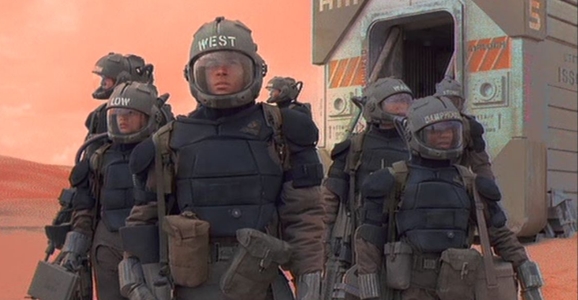 Space: Above and Beyond (1995 – 1996)
Space: Above and Beyond (1995 – 1996)
One of my earliest “I can’t believe they canceled it” traumas, Above and Beyond was a military science fiction series created by X-Files virtuosos Glen Morgan and James Wong (they penned the X-Files episodes “Squeeze,” “Beyond the Sea,” and “Die Hand die verletzt,” among others). Set in future war between humanity and the the alien “Chigs,” Above and Beyond followed the “Wildcards,” a Marine “space aviator cavalry” unit — they piloted space fighters like pros, but were also often deployed on the ground. While the gung-ho premise borrowed many of its tropes from earlier war movies, the series stitched together a really cool future mythology, including elements such as the lifelike android “Silicates,” many of which had sided with the Chigs out of resentment toward their human creators. The show also explored themes of discrimination toward “In Vitroes,” genetically engineered humans who were “born” at the physical age of 18.
Morgan and Wong supposedly had planned for the show to run five seasons, but it only survived one. Thankfully the producers had enough warning that they were able to provide some sense of closure in the finale, even with it was tragic closure. Most the the Wildcards are missing and/or presumed dead, with only Cooper Hawkes and Nathan West returning from the action. Had it continued, Damphousse (Lanei Chapman) and Vansen (Kristen Cloke) would have survived the crash of their ship but would have become prisoners of war. The Wildcards’ commanding officer Col. McQueen (James Morrison) would have been shipped back to Earth to recover from his injuries and the group would have gotten a new boss, a female officer. And, of course, the war would continue. I’d love to see it continue on the comics page, and that’s the nice thing: you totally could pick it up even nearly 20 years later…assuming there are still enough fans out there to make it financially worthwhile. (I’m not holding my breath.) You can pick up a copy of Space: Above and Beyond on DVD.
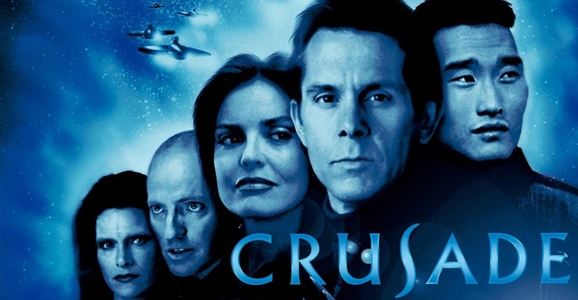 Crusade (1999)
Crusade (1999)
This is one of the more painful cancellations I’ve dealt with in my years of fandom, and the desire to see more Crusdade has only grown since its lone season aired on TNT in 1999. A spinoff from J. Michael Straczynski’s better-known Babylon 5, Crusade picked up with Earth having been poisoned by allies of the departed Shadows. In five years, every last man, woman, and child on Earth would die…unless a cure was found. And so the crew of the Excalibur, led by Captain Matthew Gideon, set out in search of that cure.
Sadly, the one threat they couldn’t defeat was boneheaded interference from the TNT suits, who seemed to have little to no interest in making the show Straczynski intended, but no shortage of truly horrible notes. And while the resulting show still has some great moments, and all the potential to have become a worthy successor to B5, it only made it 13 episodes. Which is doubly a shame, because the scripts and notes for the episodes that would have filled out the rest of the season are amazing, revealing that the plague was, in a way, a giant MacGuffin, and the series was soon to delve into more interesting things such as the legacy of the Shadows, the true nature of the Techno-Mages, the lingering dark secrets in Earth’s military, and at least one appearance by everybody’s favorite ruthless teep, Alfred Best (Walter Koenig). Of all the items on the list, this is the one I’d give my left arm to see become real. Crusade’s single season is available on DVD and Amazon Instant Video.
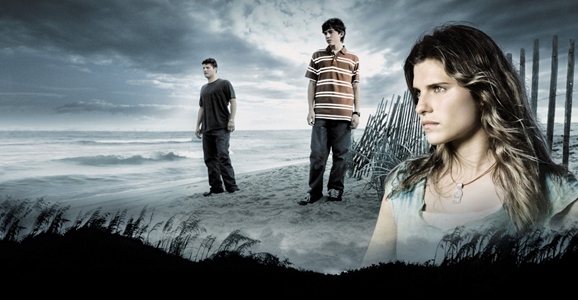 Surface (2005 – 2006)
Surface (2005 – 2006)
This is one I don’t expect to see on many other folks’ “bring it back” lists, but this show was like crack for me. I’ve always been a sucker for “strange things lurk in the deep” kind of stories (there’s a reason The Abyss is one of my favorite movies), and Surface played that card in spades. Surface centered on the notion that large, mysterious creatures were dwelling beneath the ocean, and the Powers That Be don’t seem to want anyone to know about them. We follow several different characters, each of whom has crossed paths with the beasts: an oceanographer whose submersible is attacked, a teenage boy who captures one of the species’ young, and a fisherman whose brother is dragged into the depths by one of the creatures.
As with many of the shows on this list, Surface tried to ape Lost with a complex mythology and a serialized structure that didn’t always reward casual viewing, but also like many of the shows on this list, it proved that ABC’s island drama was the exception rather than the rule. Surface only lasted 15 episodes, but in that time it built up a backstory involving clones, mysterious expeditions, government secrets, and the creatures’ less-than-charitable intentions toward us poor, dry surface dwellers. It ended with a massive tsunami — one seemingly engineered by the creatures — hitting the East Coast. In the words of Lake Bell’s Laura Daughtery, “it is a new world.” One I’d still like to see more of, even all these years later. You can watch Surface on Netflix Instant.
 Journeyman (2007)
Journeyman (2007)
There have been tons of “traveling through time to set right what once went wrong” series over the years, most notably the show I just cribbed that phrase from, Quantum Leap. Journeyman stands out among the pack thanks to laying out a genuinely intriguing cosmology beneath the time-hopping adventures of reporter Dan Vasser (Kevin McKidd). As the show’s only season unfolded, Dan began to get a better handle on his time jumps, even though he had no control over when or where they sent him. He soon discovered he was not the only jumper (I had to stop myself from typing “leaper”) — there were several more at least, including his thought-dead fiancée Livia (Moon Bloodgood), who is actually from 1948 and travels forward in time, rather than Dan’s retrograde journeys.
Journeyman creator Kevin Falls has revealed that, had the show gotten a complete first season — it only made it to 13 — Livia would have died, Dan would have gone back and saved her, but then would have returned to his present to find his wife and son vanished from the timeline. The show would have continued to explore the overall mythology of why Dan and Livia were able to travel through time, and why those trips were directed toward helping specific people. Eventually, many of the people Dan had saved would prove crucial during a “Rube Goldberg-inspired climax” for the series. Give us the comic, damn it. I love Rube Goldberg-inspired climaxes! Frustratingly, Journeyman doesn’t seem to be available on DVD or streaming here in the States, but you can get it via Amazon UK.
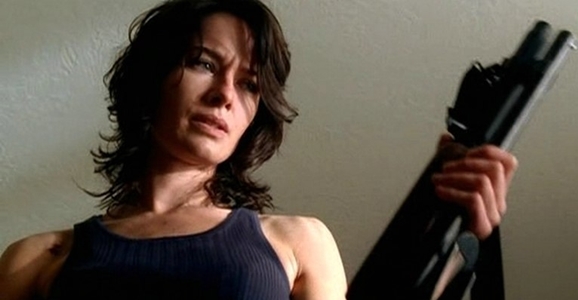 Terminator: The Sarah Connor Chronicles (2008 – 2009)
Terminator: The Sarah Connor Chronicles (2008 – 2009)
Hollywood has been trying to reinvigorate the Terminator franchise for at least a decade, but while Terminator 3: Rise of the Machines and Terminator: Salvation did okay at the box office, they’ve achieved nowhere near the critical or popular success as James Cameron’s first two Terminator films. Even now, they’re working on Terminator 5, which may or may not be a prequel, but it remains to be seen if the new film can put the spark of life back into the flailing franchise. It’s doubly sad, then, that Terminator: The Sarah Connor Chronicles defied all expectations by actually being really good, and expanding the fiction of the Terminator universe in interesting and unexpected way. So naturally, they killed it after two seasons.
And on one hell of a cliffhanger, too, something fans would no-doubt love to see resolved. Instead we’re left with John Connor dumped into the war-ravaged future, face-to-face with the Kyle and John Reese…who’ve never heard of any resistance leader named John Connor. We do know a little bit about how season three would have unfolded. Creator Josh Friedman has said that John would have grown close to Allison Young, the woman who John’s female protector Terminator Cameron was modeled after. It would have explored how the Resistance had been altered by the absence of John. A comic series would miss the talents of the show’s excellent cast, but it would still be great to see more of the story. If you’re an Amazon Prime member, both seasons of The Sarah Connor Chronicles are available for streaming.
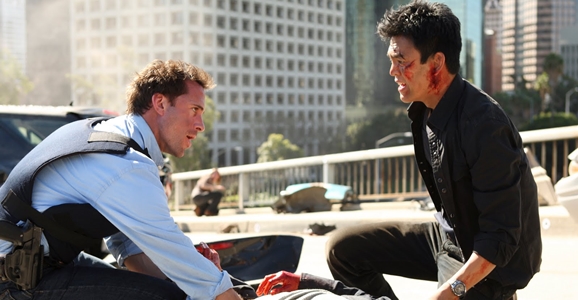 FlashForward (2009 – 2010)
FlashForward (2009 – 2010)
Based on the 1999 novel of the same name by writer Robert J. Sawyer, FlashForward opens with (nearly) every person on the planet losing consciousness for two minutes and seventeen seconds. That’d be odd enough, but during that time everyone experiences a vision of their “future” — specifically visions of April 29, 2010. Again, FlashForward was a series chasing the ridiculous success of Lost, but like so many ambitious serialized shows following the path the island drama had blazed, it died in its infancy. But it did at least get a full season’s worth of episodes on the air.
Unfortunately, FlashFoward was rarely as interesting as its core concept, and suffered from an ill-conceived hiatus that had it air just enough episodes to get people interested, only to vanish from December 2009 to March 2010, meaning many viewers had either forgotten about the show or simply lost interest. When a show that isn’t made of self-contained episodes but requires you to really pay attention to the expanding mythology, a weeks-long break in the middle of the season is kryptonite. Original showrunner David S. Goyer (who left the show midway through) intended for the characters to find an ancient device that could predict the flashforwards, and the time-distorting events would have led up to a flash that went only three days into the future…but which only 17 people on the planet would have experienced. So what the hell happened to everybody else on the planet? There’s the rub, and it would be interesting to see that future play out in comics form. You can pick up FlashForward on DVD or as a digital download.












